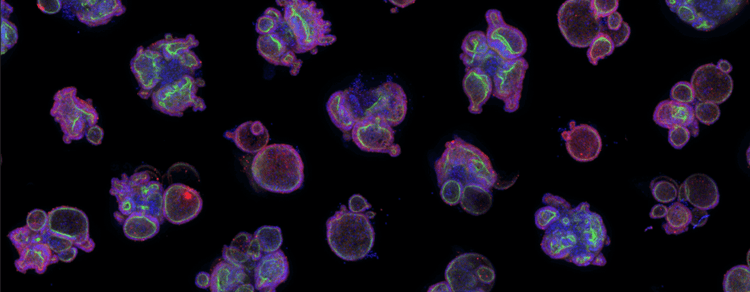
ON-DEMAND WEBINAR
New standard in organoid culture and image-based analyses
https://share.vidyard.com/watch/36rJgVKD9nrPif7n1Vkpcb
Have a question for us?
Q&A
To perform the Live/Dead assay with the organoids, did you need to clear the organoids or perform any special steps before imaging? In general, can you fix organoids directly in the Gri3D plate for imaging?
Live/Dead assay can be performed directly on all Gri3D plate formats (plastic and imaging bottom), without the need of a clearing solution. Tissues are incubated with the dyes (Calcein AM and Ethidium homodimer-1) and imaged directly on plate with no washing steps. Organoids can also be fixed for further immunostaining purposes. In that case, we recommend the use of imaging bottom Gri3D (180 μm thick bottom). Addition of a clearing solution is optional depending on the application.
Can the supernatant from these organoids be used for evaluation purposes?
Yes, since organoids are grown in suspension-like conditions and confined in the microwells, their supernatant can safely be sampled out using the pipetting port at any time during the culture. The media can then be used for a variety of cell medium based assays, such as ELISA for protein release, or LDH detection for cytotoxicity studies. Moreover, organoids can be harvested from Gri3D and processed for gene and protein expression or single-cell analyses.
How many images do you need to create a SINAP model?
The number of images required for training a robust SINAP model depends on a few factors:
- Inverse dependency on how many objects are present in an image. If each image has only one object (like a spheroid), then a higher number of images would be required
- Dependency on variability in ‘look and shape’. The more variability there is, the more images or object examples will be required
- Dependency on variability in ‘surrounding’. The more variability there is in what surrounds each object, the more example images are required
- Similarity to one of the existing models. If one of the existing models is ‘almost’ working then training a new model will require fewer images in the training set
How long does it take to train a model?
It depends on whether the fine-tune or retrain option has been chosen. Retrain takes a bit more time than fine-tuning. It also will depend on the number of images in your training set. More images will make the training process longer.
Does Molecular Devices provide any SINAP models?
Yes, we provide several validated models for the detection of nuclei and cells in fluorescent and brightfield images. We also have several SINAP models currently in pre-validation that can be provided to customers upon request.